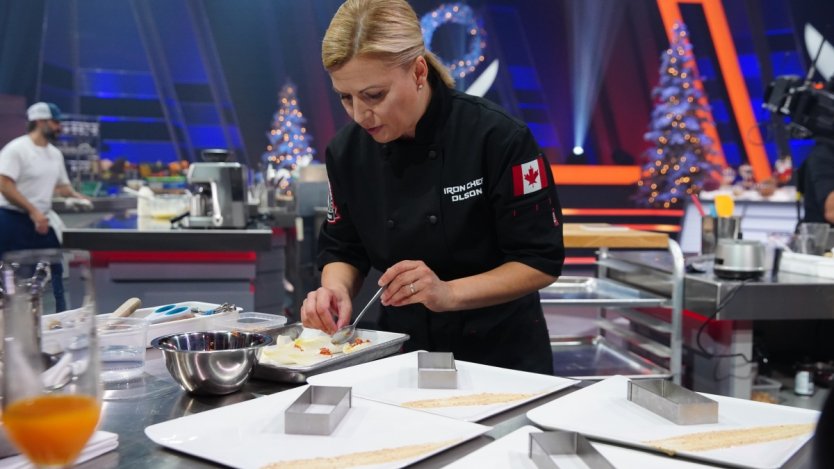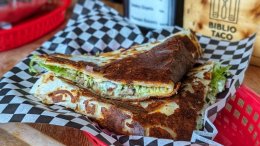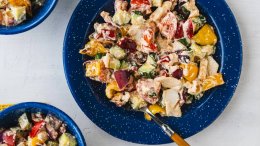Sugar, spice and everything nice could be a short and sweet way to sum up food personality and cookbook author Anna Olson. A staple on Canadian culinary television (and also in Asia as well), Olson is known well for her warm personality and intuitive approach to cooking through numerous instructional cooking programs, as well as many best-selling cookbooks.
This week, Olson takes on a bit of a different persona--a competitive one--as she makes an appearance on Iron Chef Canada, battling pastry chef Laura White in a special holiday-themed episode on Wednesday, December 12th at 10 p.m. (ET)
Though she's famous for her sweet creations, Olson also has a rich background as a savoury chef as well, working in that role years before she made the move into the pastry realm.
With her new book, Set For The Holidays with Anna Olson, out now (check out the Graceland Squares), Olson sat down to talk about getting playfully competitive for the holidays, how she stays inspired when it comes to recipe development and more.
Normally, baked goods can take quite a while to prepare, how does competing in the Iron Chef Canada stadium change your approach to that?
The very first concern and consideration I had was figuring out what techniques I could draw on that were achievable in a one-hour period. It’s not just about the bake time. Anything of a significant size can take upwards of 48 to 50 minutes. You can’t spend your time waiting for something to bake. There is also the cooling time, the setting time, the chilling time. I wanted to make sure that I was offering something to judges that showed a variety of techniques but was also achievable within an hour. So, making choices like, "OK, if I wanted to do a tart, it would have to not be a pastry crust, it’d have to be a crumb crust, which is achievable." Those were the kind of decisions I made in pre-planning, how I was going to build the menu.
You also have education background and experience as a cook outside of pastries. How do those skills help you succeed in a baking atmosphere?
That too, is a good question, and I’m actually going to flip it around and say that I found that my cooking improved when I started specializing in baking. Baking is so much about the technique and how ingredients, when combined, work in a certain way that I found my cooking repertoire and flexibility improved. That increased confidence in the science behind cooking then allowed me to stretch my boundaries when it goes back to baking.
Do you have all sorts of fundamental pastry recipes memorized?
As a pastry chef, you tend to think in ratios and you translate to weights as opposed to volume measuring. Because then when everything is in grams, you can understand: “OK, I need two-to-one butter-to-sugar to achieve result X.” You already have that in your head. You know how many eggs you need for crème brulee, etc.
What's one of the easiest pastry of baking recipes you think a home cook should aim to memorize as a fundamental culinary skill?
I think a basic sponge cake is a fundamental recipe with a beautiful ratio. It includes six whole eggs, 200 grams of sugar and 150 grams of flour.
These ingredients give you a fundamental sponge cake. You whip eggs with the sugar for about ten minutes until they double in volume, then sift in flour. The rest, you have wiggle room so you can add lemon zest, you can add vanilla, you can add a little bit of melted butter to enrich it at the end. That’s a basic sponge cake recipe and will make a nine-inch round cake or fill a shee,t pan depending on how you’d like to use it.
Your new cookbook is beautiful. We've featured your crème brulee eggnog on Eat North, and I thought that it was a really creative idea. How do you keep holiday recipes interesting after publishing so many cookbooks and hosting holiday specials for so long?
I would say listening to friends, family and my readers and viewers is a critical part of my recipe inspiration. If I’m testing a recipe and I’m getting only a mediocre response, I try and have a conversation. I remember the crème brulee eggnog recipe. I was talking to my two girlfriends about what we like about eggnog and we don’t like about eggnog. What we liked about it was that it tastes like a custard; what we didn’t like about it was that it wasn’t rich enough. We realized what was missing was that crème brulee connection. So adding the caramelized sugar on the rim of the glass and adding a little more cream than I would normally put in eggnog all of a sudden took us to something that was familiar, fulfilling at the same time and a little different.
The cheese board section of your cookbook is especially great. Why do you think a cheese board is a quintessential element of holiday entertaining?
I eat more cheese this time of year than the other months combined or every other months combined. I think it is a wonderful way to welcome your guests. While you’re busy paying attention to the roast in the oven or assembling your salad and vegetables for other courses, cheese is an easy pleaser. It doesn’t take you a lot of work, but it does take care and thought to put a cheese assortment together by flavour, by texture and by visual. I think it can really showcase your personality.













